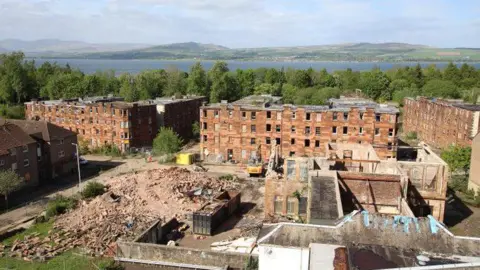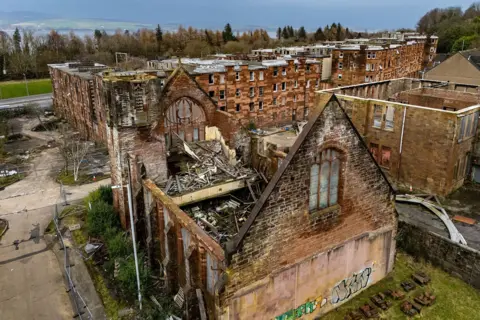Workers hurt by falling masonry at demolition site
 Inverclyde Council
Inverclyde CouncilTwo workers have been injured by a piece of falling masonry during the demolition of a derelict housing estate in Inverclyde.
The men, aged 31 and 20, were struck by the stonework at Clune Park in Port Glasgow at about 15:00 on Friday and were taken to hospital.
Neither have been seriously hurt. Demolition contractors Caskie Limited will carry out a full investigation into the circumstances.
Director Euan Caskie told the BBC the company had "robust" health and safety policy and tries to avoid such incidents at all costs.
He confirmed the men had been released from hospital on Friday evening, one with bruising, but could not comment further until employees had been interviewed.
Police were called following the incident and the health and safety executive has been informed.
Inverclyde Council said on Friday that the former church in the estate had been completely demolished after work began earlier this week.
Built in 1905, Clune Park Church was in an advanced state of decay when bulldozers moved in - its roof was completely gone with trusses piled up on Robert Street outside.
The works will also see an old primary school building and 138 properties across 15 tenement blocks razed to the ground.

The tenements at Clune Park were built a century ago as housing for shipyard workers but have lain mostly abandoned for years.
A stand-off between private landlords and the local council has prevented redevelopment, with a handful of tenants remaining.
Inverclyde Council owns a significant proportion of the estate having brought properties over a number of years.
In recent years the run-down estate has become a magnet for urban explorers and photographers, forcing the authorities to step up security patrols.
Dangerous building notices were served following investigations by the council's building standards officers and external surveyors.
It was described as "Scotland's Chernobyl" more than a decade ago and the name stuck, despite having a very different story to the Ukrainian disaster zone.
Local politicians say it was an easy badge to apply to the area because of its desolate nature.
On Friday council leader Stephen McCabe said the first phase of the demolition work was a key step towards regenerating the estate.
